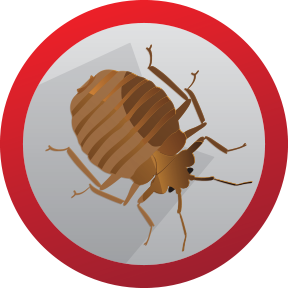 Bed bugs are parasitic insects of the cimicid family that feed solely on blood .Bed bugs normally feed on the blood of humans, but they also suck blood from other animals, birds and bats. They usually feed at night when people are asleep. When they feed, bed bugs inject a secretion into the wound which often causes the skin to itch and become swollen. It’s not a good idea to scratch the itch as it causes sores which may become infected. The adult bed bug is brown, has no wings, and is about 1/4 inch long. When bed bugs are hatched they are almost colorless and similar to the adult except they are much smaller. When they are full of blood, the body becomes swollen, and the color changes from brown to dark red. Throughout the day, bed bugs hide in many different places.
Bed bugs are parasitic insects of the cimicid family that feed solely on blood .Bed bugs normally feed on the blood of humans, but they also suck blood from other animals, birds and bats. They usually feed at night when people are asleep. When they feed, bed bugs inject a secretion into the wound which often causes the skin to itch and become swollen. It’s not a good idea to scratch the itch as it causes sores which may become infected. The adult bed bug is brown, has no wings, and is about 1/4 inch long. When bed bugs are hatched they are almost colorless and similar to the adult except they are much smaller. When they are full of blood, the body becomes swollen, and the color changes from brown to dark red. Throughout the day, bed bugs hide in many different places.
The most common hiding places are in cracks in the walls, behind baseboards, around the tufts of mattresses and in bed clothes. Bed bugs have a bad odor that comes from the oily liquid they emit. The way that bed bugs can get into your house is by being carried into homes in clothes, second-hand beds, and bedding, furniture, suitcases, or by people.
Life Cycle and Habits
When Bed bugs lay eggs they are 1/25 inch long and are slightly curved. The eggs are then fastened with a cement to any cracks, crevices or rough surfaces. The eggs hatch in between 6 to 10 days. Bed bugs have five nymphal stages, and it usually takes 35 to 48 days for nymphs to mature.
Female bed bugs can deposit 10 to 50 eggs at a time. Which means that a total of 200 to 500 eggs can be produced per female. Bed bugs can survive for six to seven months without a blood meal. They have also been known to live in abandoned houses for one and one-half years. The way that they survive without humans is by attacking birds and rodents.
Management Guidelines for Bed Bugs
Bed bugs can be particularly difficult to kill with insecticides. They do not have sticky pads on their feet, which means that when they crawl across insecticide on surfaces, the pesticide does not stick to to their bodies and, therefore, it does not kill them. In order for it to be effective, most insecticides must be applied directly to the insect. This means that getting this done requires searching for every bed bug in a room and spraying it directly. The process of finding the bug and spraying it is very labor intensive. And since eggs are not affected by the spray, the treatment has to be repeated after about two weeks to kill newly hatched nymphs.
